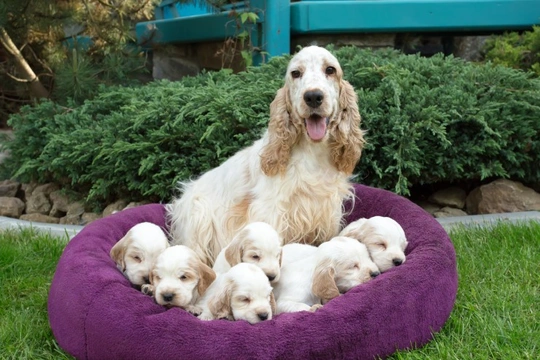
Diaphragmatic hernias in Cocker spaniel puppies
Hernias come in a range of different types and variants, which can affect different areas of the body. Some dog breeds have elevated risk factors for developing certain types of hernias, particularly when young, and one of these is the Cocker spaniel – a breed that has elevated risk factors for a type of birth defect that can lead to diaphragmatic hernias in young pups.
In this article we will explain in detail what a diaphragmatic hernia is, why Cocker spaniel pups are at higher risk than most other breeds of developing one, and how to recognise the symptoms of a diaphragmatic hernia in your own dog. Read on to learn more.
What is a diaphragmatic hernia?
A hernia is the name we use to describe what happens when an organ or bodily tissue protrudes or exits from the cavity that is should reside within, and hernias come in a range of different types and can develop in different areas of the dog’s body.
Diaphragmatic hernias develop in the dog’s diaphragm, when the muscle of the diaphragm itself is not fully developed and has a hole, or because of a tear in the muscle. This in turn means that the dog’s internal organs can push through into the pericardial sac, which protects the heart. It can also lead to fluid leaking into the lungs, compounding the issue.
Hernias can develop through an injury, trauma or internal damage, but they can also occur due to a birth defect, and diaphragmatic hernias in Cocker spaniel pups almost invariably develop due to a poorly developed diaphragm muscle, which occurs before the pup is even born.
Why are Cocker spaniels at increased risk of diaphragmatic hernias?
Diaphragmatic hernias are by no means common in Cocker spaniel pups, but this dog breed does have more than its fair share of pups with the condition, which indicates that a hereditary factor makes the breed itself or certain bloodlines within it more predisposed to the problem.
We aren’t quite sure why this is, but as is the case with virtually all pedigree dog breeds, genetic and hereditary health issues can develop within any dog or breed line, but most commonly occur within pedigree breeds due to their smaller gene pools and so, increased chances of a limited level of genetic diversity within the breed, which reinforces recessive gene mutations.
There is no way to find out prior to purchasing a Cocker pup whether they may have a diaphragmatic hernia, but asking the breeder if any of the pup’s relatives have had a diaphragmatic hernia can help you to predict the potential risk factors.
What are the symptoms of a diaphragmatic hernia in a puppy?
If a Cocker pup is born with a diaphragmatic hernia, this may become evident to their breeder whilst the pup is still very young. However, this is not always the case, and in some presentations of the condition, an apparently healthy pup will already have been sold on to their future home before the issue becomes apparent or acute enough to be noticeable in the pup’s development and behaviour.
Additionally, how easy or otherwise it is to diagnose a diaphragmatic hernia depends on how acute it is upon examination, and the symptoms that it causes in the pup itself.
The first symptoms you may identify at home include laboured breathing or apparent difficulty breathing normally and comfortably, and potentially, problems with the digestive system, eating, and processing milk or solid foods.
Some pups who are born with a diaphragmatic hernia may also exhibit a range of other related or unrelated birth defects too, although this is not always the case. When your vet examines the pup, they may identify cardiovascular symptoms such as the presence of a heart murmur, or occluded or abnormal heart sounds.
In very severe cases of diaphragmatic hernias in Cocker pups, the pup may appear to be obviously ailing from birth or soon afterwards, and may be unable or unwilling to nurse, showing signs of fading and potentially shock within their first few hours or days of life.
Can a diaphragmatic hernia in a puppy be treated?
First of all, your vet will need to examine your pup and will also run a range of other tests in order to confirm their diagnosis. These tests may include both x-ray and ultrasound examination, and potentially blood and urine panels too, as well as asking for more information on the symptoms you have noticed at home and any other problems that the pup may have.
How your vet proceeds with treatment from there will depend on a range of factors, including the age and size of the pup, their general health and condition, and the severity of the hernia itself and how it might progress.
If the pup isn’t tiny and is otherwise healthy, your vet may recommend scheduling a corrective surgery as soon as possible, to close the hole, restore the herniated sections to their appropriate locations in the body, and correct the issue.
However, if the pup is too small or otherwise unwell, surgery may have to wait until the right time for it to be viable, which means that the pup will need to be monitored and stabilised before surgery can take place. Generally, a diaphragmatic hernia will be repaired as soon as it is viable to do so, in order to reduce the risks of secondary complications and further problems such as strangulation of an organ or tissue, or the formation of scar tissue around the hole, which can make it hard or impossible to close and keep closed.



